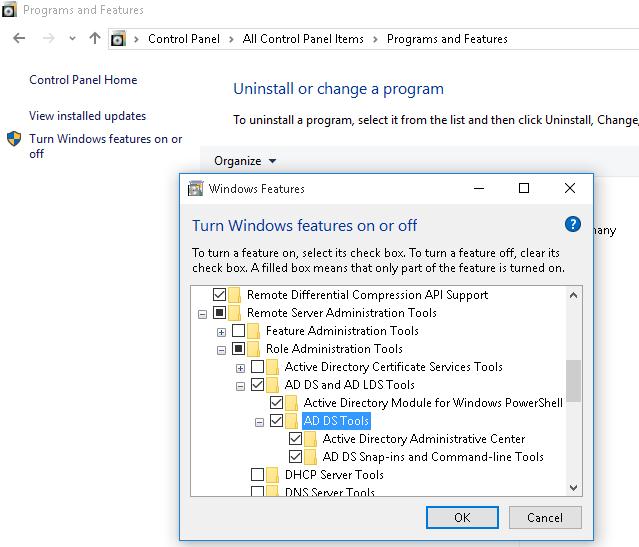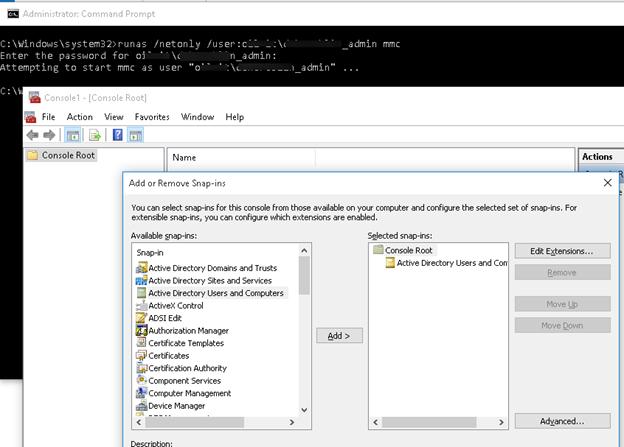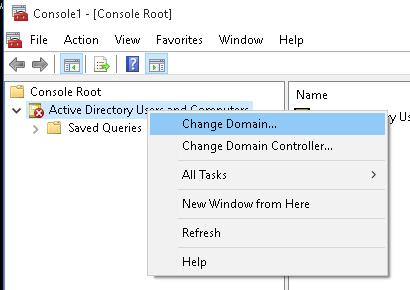Все способы:
- Способ 1: Штатные «Параметры»
- Способ 2: Официальный сайт Microsoft
- Шаг 1: Скачивание и установка программного компонента
- Шаг 2: Активация
- Подключение консоли
- Вопросы и ответы: 0
Способ 1: Штатные «Параметры»
По умолчанию службы каталогов Active Directory отсутствуют в операционной системе Windows 10, но их можно скачать вручную. Встроенные возможности «десятки» позволяют инсталлировать средства доменных служб Active Directory и облегченного доступа к каталогам.
Следует отметить, что данный компонент совместим исключительно с такими редакциями операционки, как Professional и Enterprise.
- Нажмите на кнопку «Пуск» и выберите запуск штатных «Параметров».
- Перейдите в раздел «Система».
- В следующем окне на панели слева выберите вкладку «Дополнительные компоненты», а в центральной части окна кликните по кнопке «Добавить компонент».
- В строке поиска введите запрос, указанный ниже. После этого отметьте галочкой соответствующий пункт и нажмите на кнопку «Установки».
Средства удаленного администрирования сервера: средства доменных служб Active Directory и служб облегченного доступа к каталогам
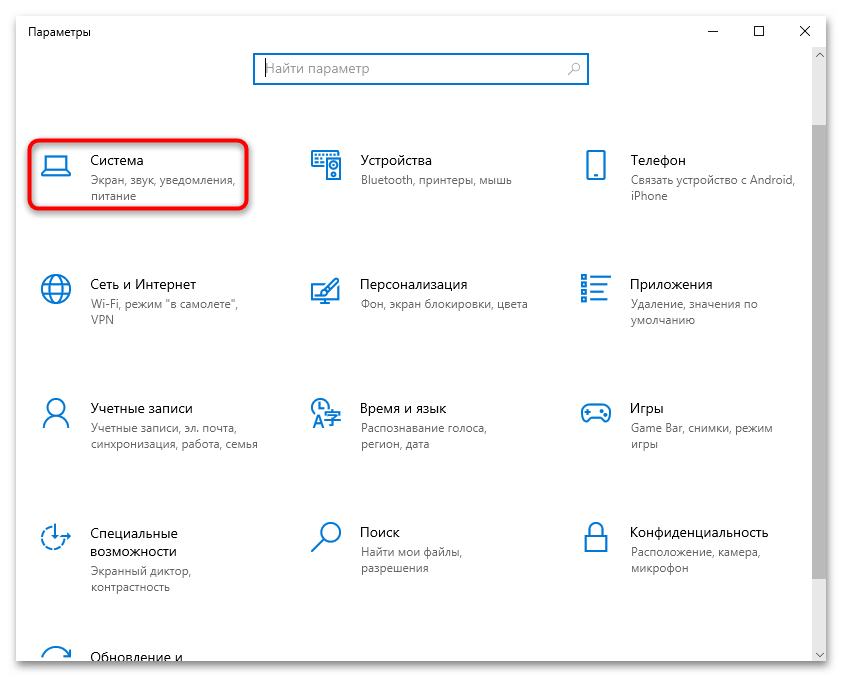
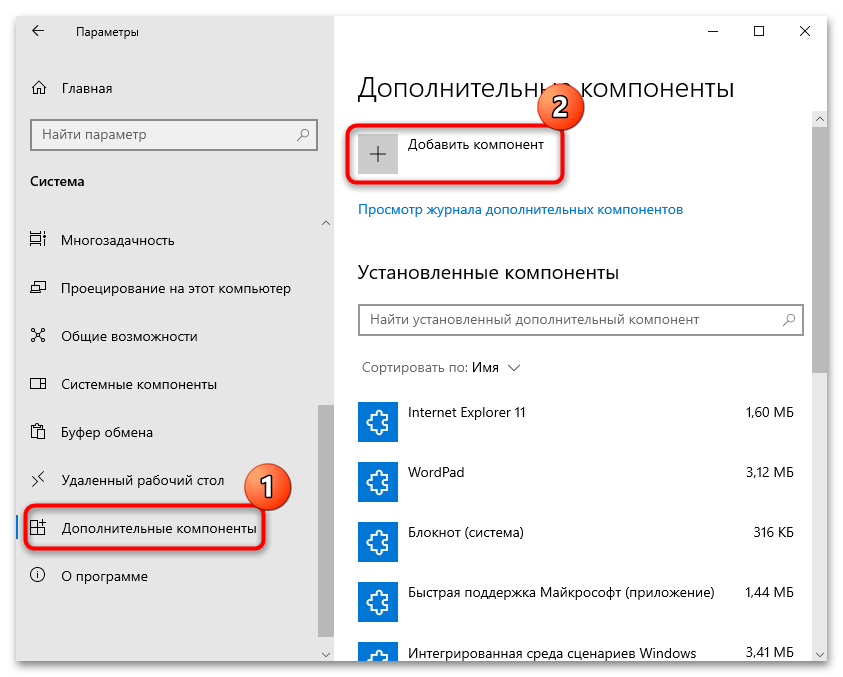

Останется дождаться, когда программный компонент будет установлен. После этого перезагрузите компьютер – нужные службы должны начать функционировать. Для запуска консоли ADUC воспользуйтесь командой dsa.msc в диалоговом окне «Выполнить» (для его вызова нажмите на клавиши «Win + R»).
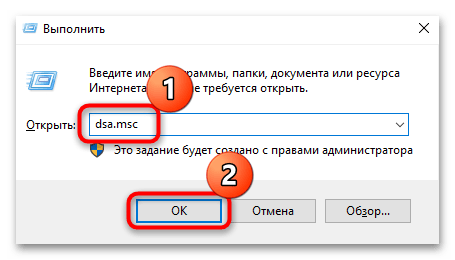
Консоль будет доступна при условии, что пользователь имеет права администратора домена.
Способ 2: Официальный сайт Microsoft
Выше мы рассмотрели способ добавления служб, отвечающих за работу консоли Active Directory. Если у вас не предустановлено данное средство, то потребуется отдельно скачать программный компонент и активировать его, затем выполнить непосредственное подключение консоли ADUC к домену из рабочей группы. Этот вариант стоит рассмотреть более развернуто.
Шаг 1: Скачивание и установка программного компонента
Для начала скачайте необходимый программный компонент с официального сайта компании Microsoft.
Перейти к скачиванию RSAT с официального сайта Microsoft
- Перейдите по ссылке выше, затем на открывшейся странице оставьте язык «English» и нажмите кнопку «Download».
- В новом окне выберите инсталляционный файл, который соответствует разрядности вашей операционной системы, и кликните по кнопке загрузки. Запустите скачанный файл, чтобы добавить консоль на компьютер. В ходе инсталляции может потребоваться дополнительно установить нужные обновления для операционной системы.
Читайте также: Определяем разрядность используемой ОС Windows 10
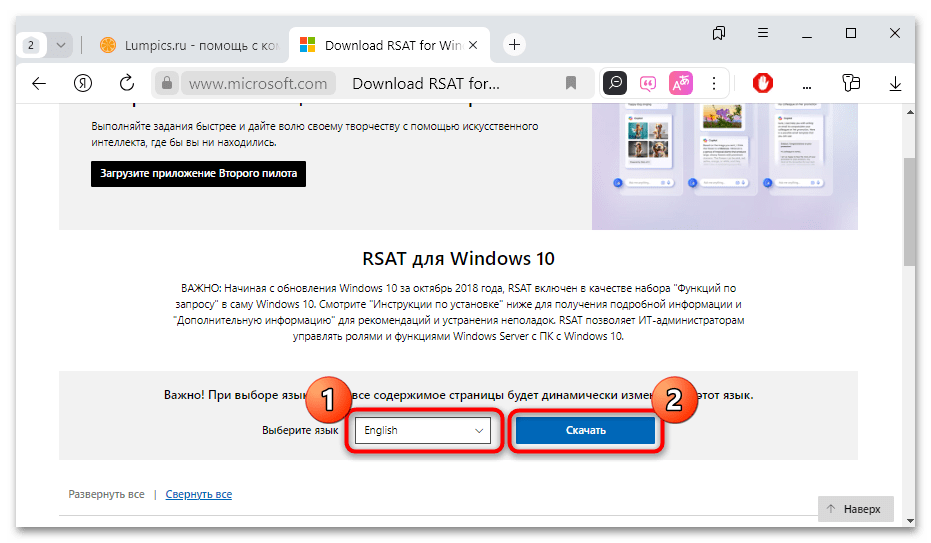
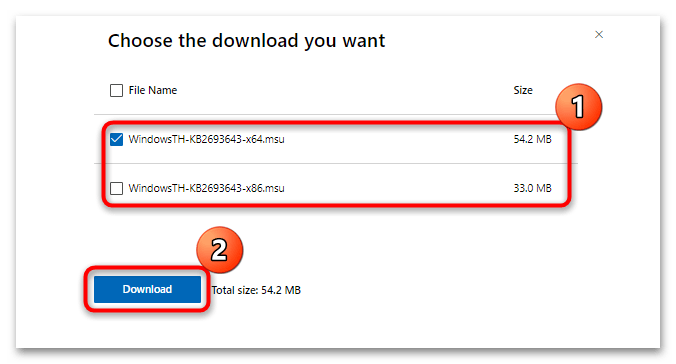
После того как все необходимые программные компоненты будут установлены в систему, обязательно перезагрузите компьютер, и можно переходить к активации консоли.
Шаг 2: Активация
Остается включить непосредственно Active Directory. Для начала запустите классическую «Панель управления» и перейдите в раздел с программами, чтобы активировать некоторые компоненты:
- Найдите встроенное средство с помощью строки системного поиска.
- В качестве просмотра разделов оставьте «Категория» и кликните по разделу «Программы».
- Затем щелкните по строке «Включение или отключение компонентов Windows».
- В новом окне разверните ветку «Remote Server Administration Tools», затем отметьте галочкой в чекбоксе все пункты и сохраните настройки.
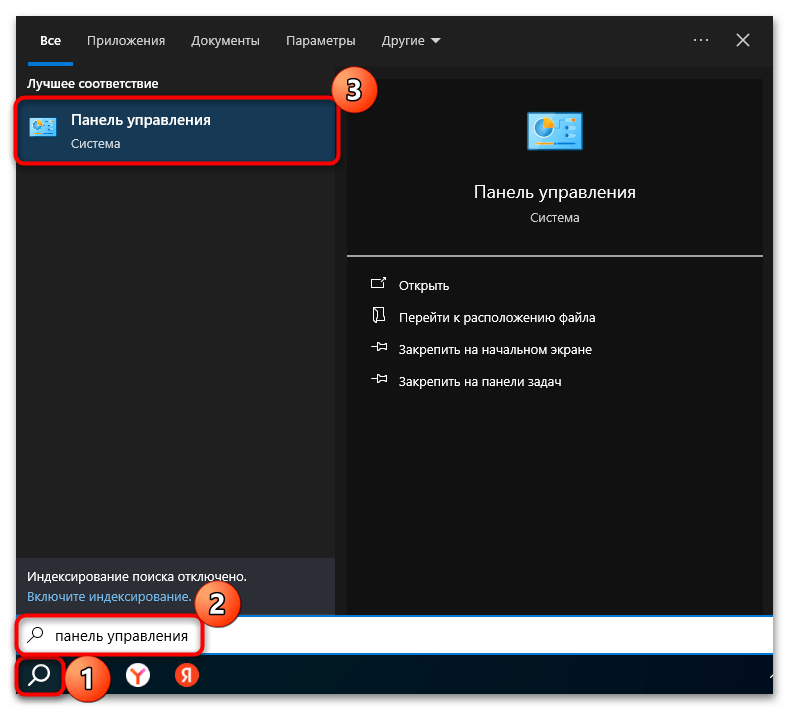
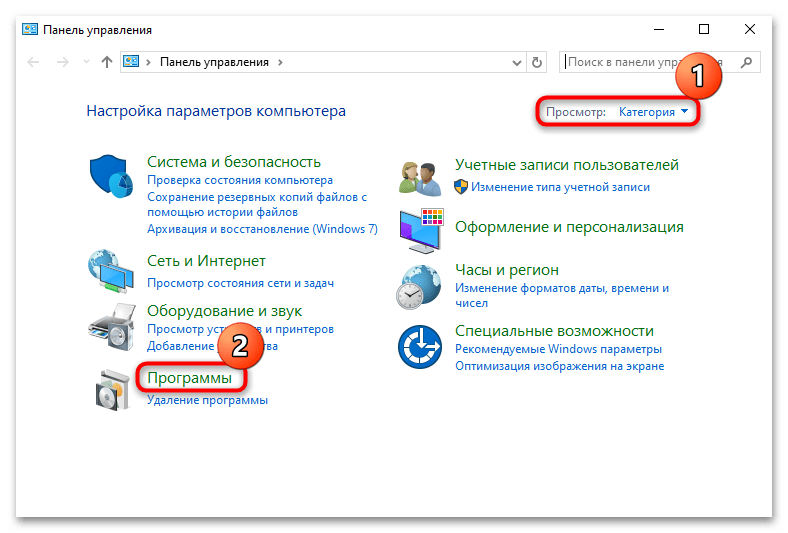
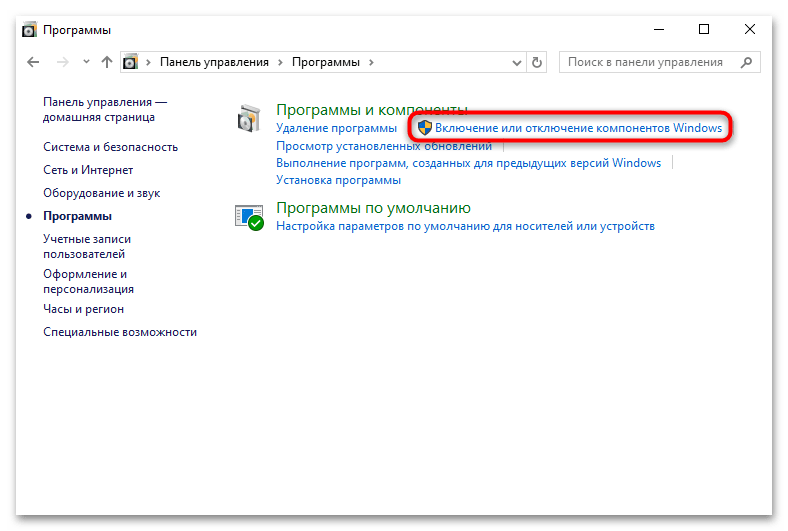
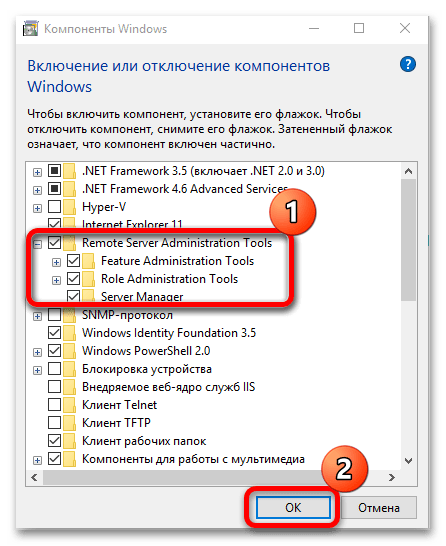
Как только включение Active Directory завершится, перезагрузите компьютер. Компонент активируется в системе, после чего можно пользоваться его функциями.
Также средства администрирования консоли ADUC включаются с помощью специальных команд, выполненных в «Командной строке», которая, в свою очередь, должна быть запущена от имени администратора. Вводите следующие запросы, выполняя их поочередно с помощью клавиши «Enter»:
dism /online /enable-feature /featurename:RSATClient-Roles-AD
dism /online /enable-feature /featurename:RSATClient-Roles-AD-DS
dism /online /enable-feature /featurename:RSATClient-Roles-AD-DS-SnapIns
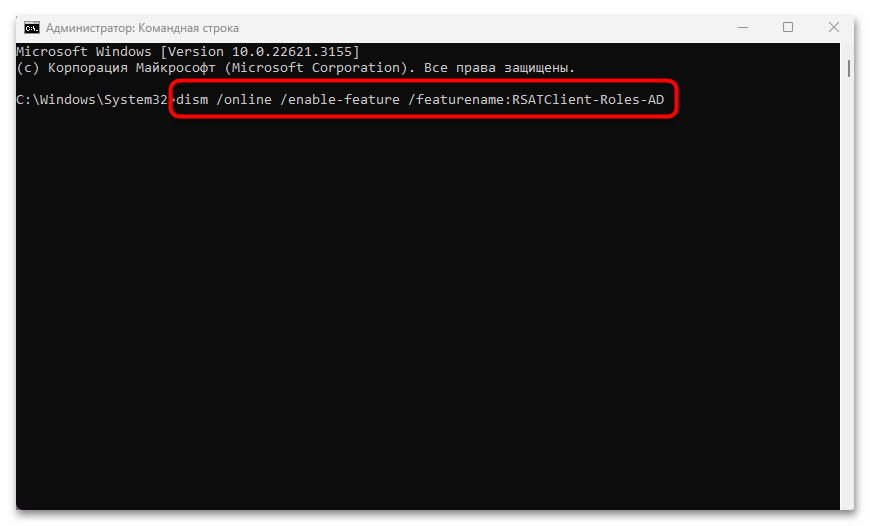
В «Панели управления» после этого можно проверить, появились ли средства администрирования в соответствующем разделе. Кликните по пункту «Система и безопасность», затем выберите «Инструменты Windows».
Подключение консоли
Также следует разобраться, как подключить ADUC к домену. Потребуется открыть консоль MMC (специальную консоль для управления различными оснастками Windows) и добавить средство.
- Через диалоговое окно «Выполнить» (одновременное нажатие на клавиши «Win + R») вызовите соответствующую оснастку, введя команду
mmc. - В появившемся окне нажмите на вкладку «Файл», затем на строку «Добавить или удалить оснастку».
- В списке справа открывшегося окна выделите пункт «Active Directory – пользователи и компьютеры» и нажмите на кнопку «Добавить».
- В окне справа появится новая оснастка — сохраните изменения нажатием кнопки «ОК».
- На панели слева в главном окне консоли MMC появится выбранный инструмент. Чтобы подключить его к домену в рабочей группе, кликните по названию правой кнопкой мыши и выберите пункт «Сменить домен».
- В новом окне введите домен и сохраните настройки.
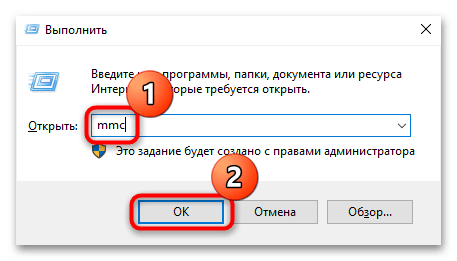
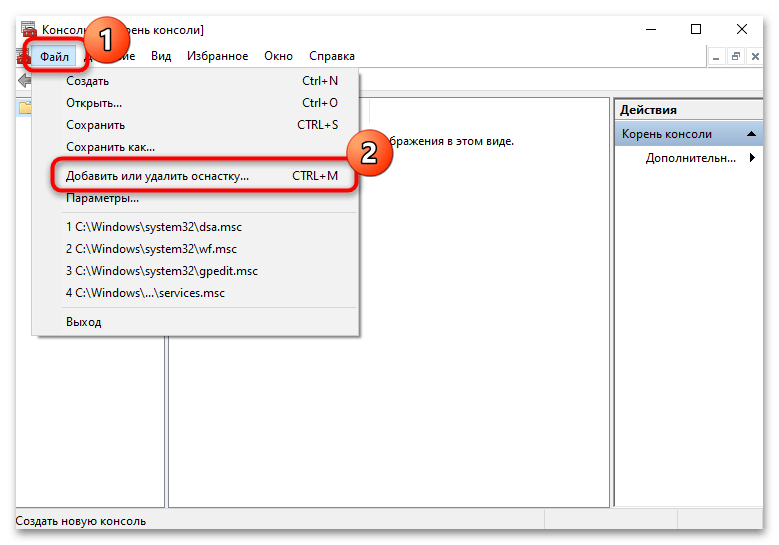
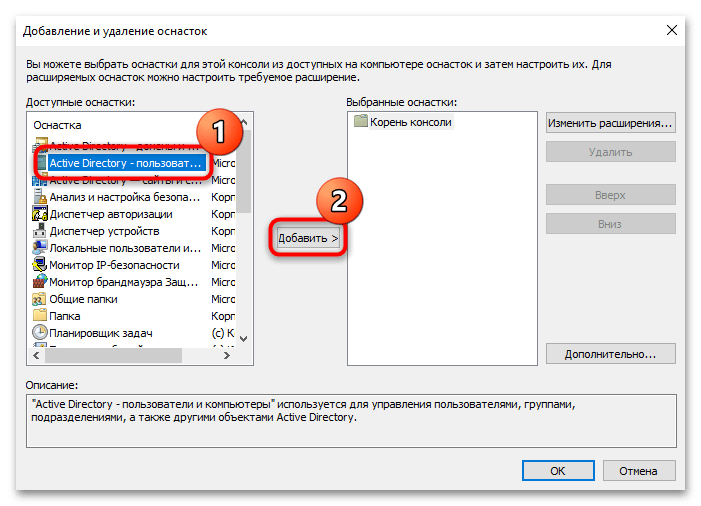
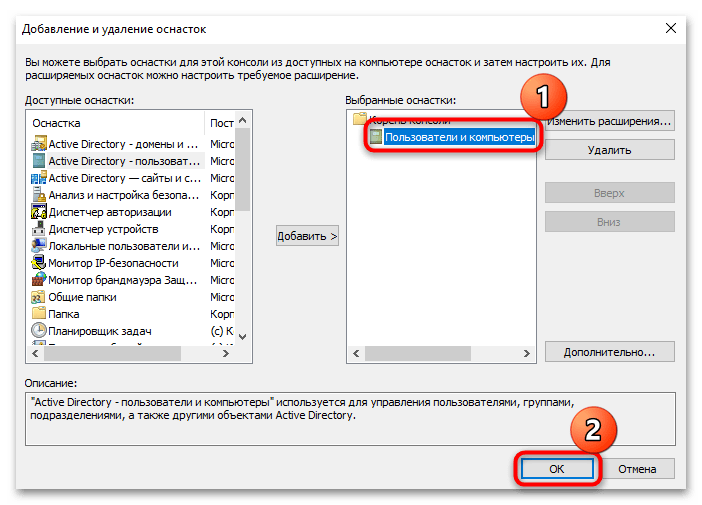
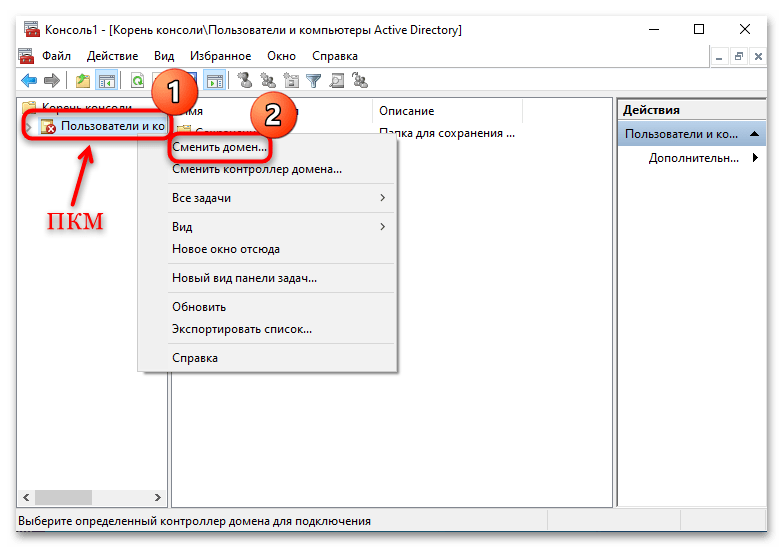
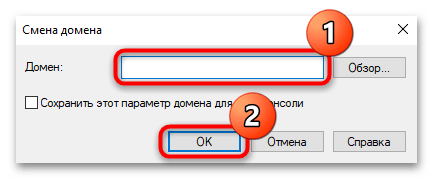
Созданную консоль можно сохранить в формате MSC для последующего быстрого запуска с помощью окна «Выполнить» и соответствующего запроса. В этом случае через вкладку «Файл» выбирается пункт «Сохранить как».
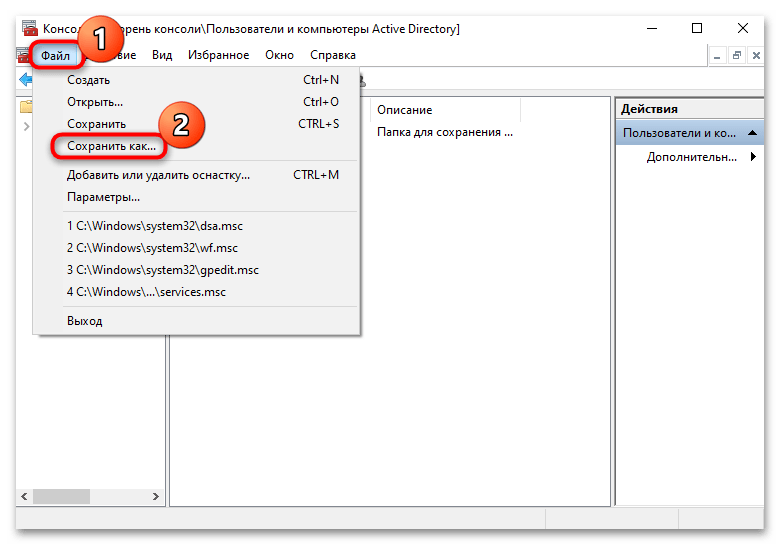
В конце останется задать имя будущей оснастке и сохранить изменения. Она должна появиться в разделе со средствами администрирования Windows.
Наша группа в TelegramПолезные советы и помощь
Enabling Active Directory in Windows 10 is a process that opens up a range of management tools for your network. This process is pretty straightforward, involving a few simple steps that anyone can follow. By the end of this, you’ll have the Active Directory Users and Computers feature ready for use.
Before we dive in, know that enabling Active Directory on Windows 10 involves installing a feature called RSAT (Remote Server Administration Tools). This will allow you to manage Active Directory through your machine.
Step 1: Open Settings
First, you need to access the Windows Settings.
You can do this by clicking on the Start menu and then selecting the gear icon to open Settings. This is where you’ll find all the system settings and features you can tweak on your PC.
Step 2: Go to Apps
Next, navigate to the Apps section within Settings.
In this section, you’ll see all the apps and features installed on your computer. This is where you’ll manage your RSAT tools.
Step 3: Select Optional Features
Inside the Apps section, look for Optional Features and click on it.
Here, you’ll see additional features you can add to your Windows setup. Optional Features is like a treasure chest of extra tools.
Step 4: Add a Feature
Now, click on the «Add a Feature» option.
This will bring up a list of features you can add to your Windows system. It’s a bit like adding new tools to your toolbox.
Step 5: Search for RSAT
Search for «RSAT» in the search bar.
When you type in RSAT, the list will filter to show you the available RSAT tools. These tools help you manage different parts of your network.
Step 6: Install RSAT: Active Directory Domain Services and Lightweight Directory Tools
Select RSAT: Active Directory Domain Services and Lightweight Directory Tools and click Install.
This tool is essential for managing Active Directory. The installation might take a few minutes, so be patient.
Step 7: Restart Your Computer
Finally, restart your computer to complete the installation process.
A quick reboot ensures everything is set up correctly and that your new tools are ready to go.
Once you’ve completed these steps, you should see the Active Directory Users and Computers tool in your Windows Administrative Tools menu.
Tips for Enabling Active Directory in Windows 10
- Make sure your Windows 10 version is up-to-date before installing RSAT.
- You may need admin rights on your computer to install these features.
- If you encounter errors, check for any pending Windows updates and install them.
- Ensure your network settings are correctly configured; Active Directory relies on network communication.
- Keep your system secure by regularly updating your RSAT tools and related software.
Frequently Asked Questions
What is Active Directory?
Active Directory is a Microsoft service that helps manage network resources like users, computers, and other devices.
Do I need admin rights to enable Active Directory?
Yes, installing RSAT tools requires administrative privileges on your computer.
Can I enable Active Directory on Windows 10 Home?
No, RSAT tools can only be installed on Windows 10 Pro, Enterprise, and Education editions.
What if the RSAT tools don’t show up in Optional Features?
Make sure your Windows 10 is updated. Sometimes, an outdated version can cause this issue.
Is it safe to enable Active Directory on my computer?
Yes, as long as you follow the correct installation steps and keep your system updated, it’s safe.
Summary of Steps
- Open Settings.
- Go to Apps.
- Select Optional Features.
- Add a Feature.
- Search for RSAT.
- Install RSAT: Active Directory Domain Services and Lightweight Directory Tools.
- Restart Your Computer.
Conclusion
Enabling Active Directory in Windows 10 is a crucial task for anyone managing a network. It’s like unlocking a secret door to a room full of powerful management tools. The steps are straightforward, and even though the process involves a few clicks here and there, it’s something you can easily handle.
By following the steps outlined above, you’ll have the RSAT tools installed and ready to manage your Active Directory. Remember to keep your system updated and secure, as this will help you avoid any issues down the road.
If you found this guide helpful, consider exploring more about network management and the other tools available within RSAT. Knowledge is power, and the more you know about managing Active Directory, the better you can handle your network’s needs. Happy managing!
Matt Jacobs has been working as an IT consultant for small businesses since receiving his Master’s degree in 2003. While he still does some consulting work, his primary focus now is on creating technology support content for SupportYourTech.com.
His work can be found on many websites and focuses on topics such as Microsoft Office, Apple devices, Android devices, Photoshop, and more.
Оснастка Active Directory Users and Computers (или ADUC) – это одна из наиболее часто используемых консолей управления объектами в домене Active Directory. Вы можете установить mmc оснастку ADUC как на Windows Server, так и на десктопные Windows 10 и 11. Консоль ADUC входит в состав набора компоненту администрирования Microsoft Remote Server Administration Tools (RSAT). В этой статье мы покажем, как установить и использовать консоль управление Active Directory Users and Computers в Windows.
Содержание:
- Установка оснастки RSAT Active Directory в Windows 10 и 11
- Как пользоваться консолью Active Directory?
- Подключение консоли ADUC к домену из рабочей группы
Установка оснастки RSAT Active Directory в Windows 10 и 11
В современных версиях Windows 10 (начиная с билда 1809) и в Windows 11 инструменты администрирования RSAT устанавливаются онлайн в виде Features on Demand. Чтобы установить инструменты администрирования RSAT Active Directory в Windows 10/11, перейдите в Settings -> Apps -> Optional Features -> Add an optional feature (View features).
Наберите в поисковой строке Active Directory и выберите для установки компонент RSAT: Active Directory Domain Services and Lightweight Directory Services Tool.
Нажмите Next-> Install для начала установки.
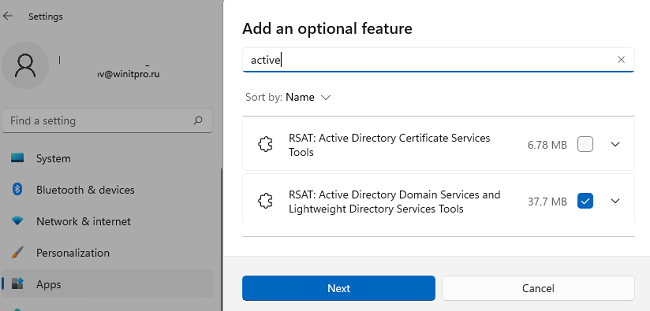
Windows подключится к серверам Microsoft, скачает и установит набор инструментов для управления Active Directory (включает в себя графические консоли Active Directory, утилиты командной строки и модуль Active Directory PowerShell).
Либо вы можете установить набор компонентов администрирования AD с помощью PowerShell:
Add-WindowsCapability –online –Name Rsat.ActiveDirectory.DS-LDS.Tools~~~~0.0.1.0
В изолированных сетях, в которых нет доступа в интернет, вы можете установить инструменты RSAT Active Directory с помощью ISO образа Windows 10 Features on Demand (образ FoD можно скачать из кабинета лицензирования Microsoft).
Для установки инструментов Active Directory, из сетевого каталога с содержимым образа FoD выполните команду:
Add-WindowsCapability -Online -Name Rsat.ActiveDirectory.DS-LDS.Tools~~~~0.0.1.0 -LimitAccess -Source \\fs01\Distr\Windows10-FOD\
В предыдущих билдах Windows 10, а также в Windows 8.1, установить RSAT можно с помощью MSU обновления. Скачать RSAT можно здесь:
- RSAT для Windows 10 1803/1709 — https://www.microsoft.com/en-us/download/details.aspx?id=45520
- RSAT для Windows 8.1 — https://www.microsoft.com/en-us/download/details.aspx?id=39296
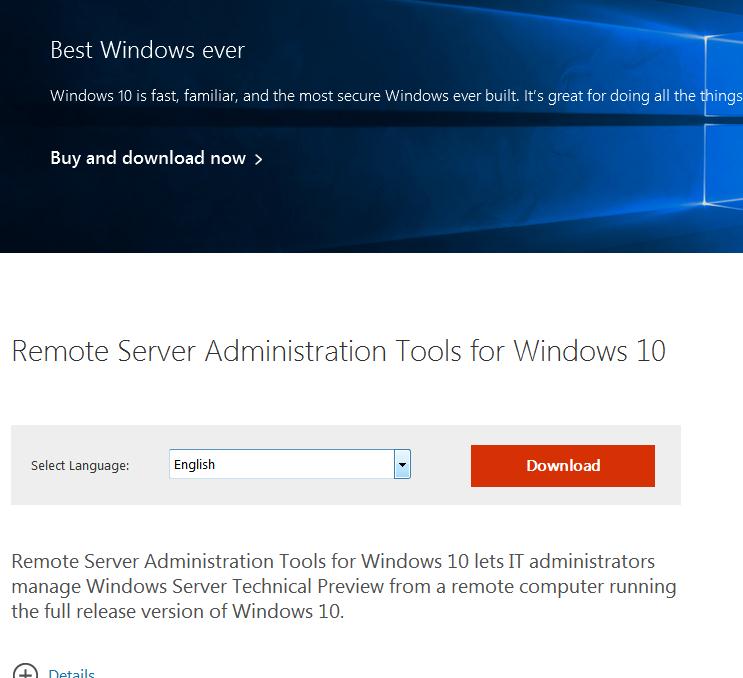
Скачайте версию файла RSAT в зависимости от разрядности вашей операционной системы и установите его. Дважды щелкните по файлу для начала установки:
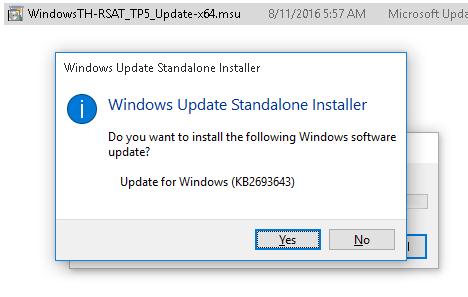
Или установите MSU файл RSAT из командной строки в «тихом» режиме:
wusa.exe c:\Install\WindowsTH-RSAT_TP5_Update-x64.msu /quiet /norestart
После окончания установки RSAT нужно перезагрузить компьютер.
Осталось активировать необходимый функционал RSAT. Для этого:
- Щелкните ПКМ по кнопке Start и выберите Control Panel (Панель управления)
- Выберите Programs and Features (Программы и компоненты)
- В левой панели нажмите кнопку Turn Windows features on or off
- В дереве компонентов разверните Remote Server Administration Tools-> Role Administration Tools -> AD DS and AD LDS Tools
- Отметьте раздел AD DS Tools и нажмите OK.
Установка оснастки ADUC также может быть выполнена из командой строки. Последовательно выполните 3 команды:
dism /online /enable-feature /featurename:RSATClient-Roles-AD
dism /online /enable-feature /featurename:RSATClient-Roles-AD-DS
dism /online /enable-feature /featurename:RSATClient-Roles-AD-DS-SnapIns
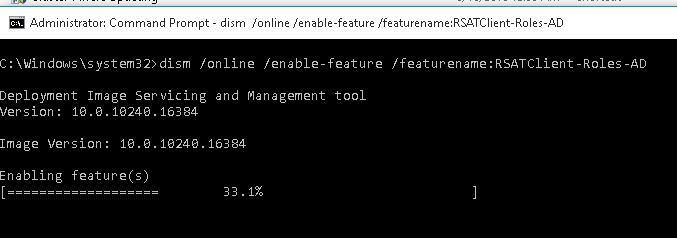
После установки оснасток управления, в разделе Administrative Tools панели управления (Control Panel\System and Security\Windows Tools) появится ссылка на консоль Active Directory Users and Computers.
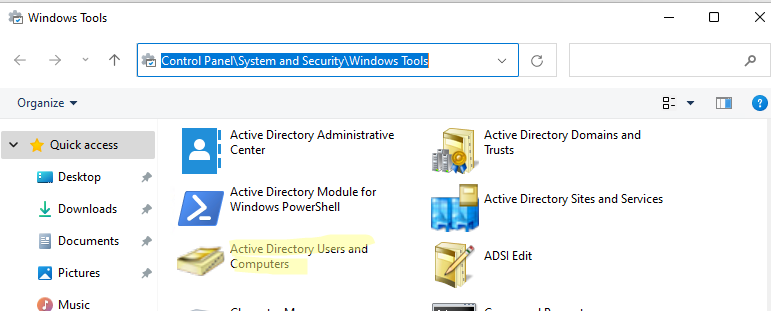
Как пользоваться консолью Active Directory?
Чтобы запустить консоль ADUC, щелкните по ярлыку в панели управления или выполните команду:
dsa.msc
Все аутентифицированные пользователи домена могут использовать консоль ADUC для просмотра объектов Active Directory.
Если ваш компьютер состоит в домене Active Directory, то консоль ADUC подключится к контролеру домена, на основании текущего Logon сервера. Имя контроллера домена, с которого вы получаете информации указано в верху.
Вы можете подключиться к другому контроллеру домена AD или другому домену, щелкнув по корню консоли и выбрав пункт в контекстном меню.
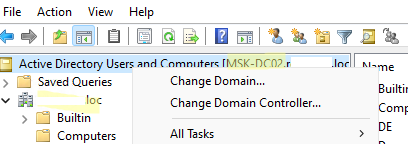
В консоли Active Directory отображается древовидная структура организационных юнитов (Organizational Unit, OU) вашего домена (и отдельный раздел с сохраненными запросами/ Saved Queries AD).
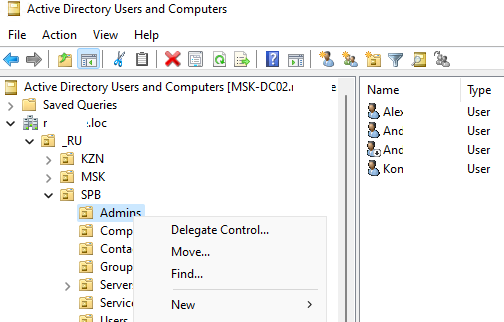
Администратор домена может создавать контейнеры (OU) в соответствии с физической или логической структуры предприятиями. С помощью контекстного меню можно создать новые объекты в AD (пользователей, группы, компьютеры, OU, контакты), переименовать, переместить или удалить объекты. В зависимости от типа объекта, который вы выбрали пункты контекстного меню могут отличаться.
Например, у пользователя есть опции на сброс пароля в AD или блокировку/разблокировку учетной записи.
Вы можете использовать контекстное меню Search для поиска объектов в AD.
Администратор может делегировать права на создание/редактирование/удаление объектов в Active Directory другим пользователям или группам.
С помощью меню View -> Add/Remove columns можно добавить атрибуты объектов, которые вы хотите отображать в консоли ADUC.
В консоли ADUC можно посмотреть или изменить свойства объектов домена. Например, можно открыть свойства пользователя и изменить его настройки. Часть свойств пользователя находится на соответствующих вкладках, а полный список атрибутов пользователя доступен на вкладке редактора атрибутов AD (Attribute Editor).
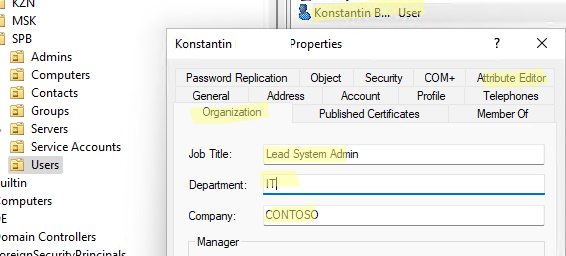
Можно добавить отдельную вкладку с фотографией пользователя AD.
Чтобы показывать системные контейнеры и свойства объектов в оснастке AD (по умолчанию скрыты), включите опцию View -> Advanced features.
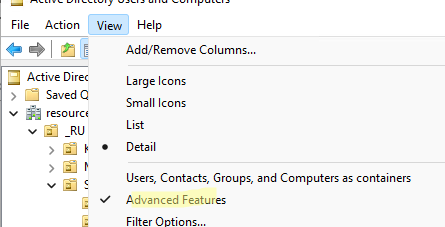
После этого у всех объектов появится ряд системных вкладок. Например, на вкладке Object можно получить каноническое имя объекта, дату создания учетной записи и включить опцию защиты от удаления (protect object from accidental deletion).
Подключение консоли ADUC к домену из рабочей группы
Если вы хотите подключится консолью ADUC к контроллеру домена с компьютера, который не включен в домен (состоит в рабочей группе), воспользуйтесь таким методом:
- Запустите командную строку и выполните команду запуска оснастки от имени другого пользователя:
runas /netonly /user:winitpro\aaivanov mmc - В пустой консоли MMC выберите File->Add/Remove Snap-In
- Перенесите оснастку Active Directory Users and Computers в правую панель и нажмите Add;
- Чтобы подключится к домену, щелкните по корню консоли и выберите Change domain. Укажите имя домена.
В результате консоль ADUC подключится к контроллеру домена, получит и отобразит структуру контейнеров (OU) данного домена Active Directory.
Active Directory manages Windows Server Technical Preview. It is a tool used by administrators to grant permission and to access resources on the network. It is not installed on Windows PCs, by default. However, you can get it online from the official website of Microsoft and install it on your device. Are you confused about how to use Active Directory in Windows 10? If the answer is Yes, this article will help you on how to enable Active Directory in Windows 10.

Please ensure that your system is connected to the internet, before implementing the below-mentioned steps.
Step 1: Install Remote Server Administration Tools (RSAT)
Note: RSAT is only supported on Windows 10 Professional and Windows 10 Enterprise versions. Other versions of Windows are not compatible with it.
1. Sign in to your system and wait for the system to start up properly.
2. Now, open a Browser e.g. Microsoft Edge, Chrome, etc.
3. Go to the Remote Server Administration Tools for Windows 10 page on the Microsoft website. This will open the web page containing the tool to be downloaded.

4. Select your Language preference in the dropdown box as shown in the above picture. Then, click on Download which is displayed in a red-colored box.
Note: Selecting the desired language will dynamically change the complete page content to that language.
5. Now, on the next page, choose the File Name you want to download. The File Size will be displayed on the right side of the screen. Refer to the picture below.

6. Once you have selected the file, it will be displayed in the Download Summary. Now, click on Next.

7. Click on the Control + J keys to view the progress of the downloads in the Chrome browser.
8. Wait for the download to be completed; go to Downloads in your system.
9. Install RSAT using the downloaded file. Double-click on the downloaded file and it will ask for permission, click on the “Yes” button.

10. Once you have installed RSAT, your system is ready to use Active Directory.
Also Read: Install Remote Server Administration Tools (RSAT) on Windows 10
Step 2: Enable Active Directory in Windows 10
Active Directory can be easily accessed with the help of Remote Server Administration Tools. Follow the below-mentioned steps to activate Active Directory in Windows 10:
1. Go to the Search menu and type Control Panel.

2. Click on Open as depicted in the above picture.
3. You will see the control panel window on the screen. Now, click on Programs.
4. Now, the Programs windows will pop up on the screen. Click on Turn Windows features on or off as shown below.

5. Now, scroll down, checkmark “Remote Server Administration Tools.” Then click on the + icon next to it.

6. Under Remote Server Administration Tools, checkmark ‘Role Administration Tools.‘
7. Next, click on the + symbol next to the Role Administration Tools.
8. Here, select AD DS and AD LDS Tools. Once you check the boxes, some files will be installed in your system.

9. Restart your PC to save changes.
Wait for some time for the process to be completed. Once done, your PC will restart and Active Directory will be enabled on your system. You will be able to access the tool from Windows Administrative Tools.
Recommended:
- The directory name is an invalid error [SOLVED]
- Disable Active Hours for Windows 10 Update
- How to Fix Printer Not Responding in Windows 10
- 3 Ways to Add Yahoo Mail to Android
We hope that this guide was helpful and you were able to enable Active Directory in Windows 10. If you have any queries/comments regarding this article, then feel free to drop them in the comments section.
Any Windows Server administrator must have used the Active Directory Users and Computers (ADUC) Microsoft Management Console on a Domain Controller (DC). Using this console, you can control and manage users, user groups, computers, and the Organizational Units (OUs) in the domain.
The ADUC console is no longer limited to servers anymore. You can install the Active Directory Users and Computers snap-in on a Windows 11 or Windows 10 computer as well, which performs the same functions as the original Server console. This snap-in is part of the Remote Server Administration Tools (RSAT) for Windows operating systems.
We have written separate posts for installing any RSAT tools on Windows 11 and Windows 10. This article focuses on installing specifically the Active Directory Users and computers snap-in on a Windows PC and then using it to manage your domain.
Table of Contents
How to Install Active Directory Users and Computers (ADUC) on Windows
All RSAT tools, including the Active Directory Users and Computers snap-in, allow you to manage the different Active Directory components as if you are on the server itself. This way, you do not always have to access the server, neither physically nor remotely, to perform an action.
You can download and install the Active Directory Users and Computers snap-in using the Settings app, from the Command Prompt, and Windows PowerShell.
Note: On Windows 10 v1803 and older, you must download and install all RSAT tools using the MSI files. You can find the MSI files for your version of Windows here.
Install Active Directory Users and Computers from Settings App
The easiest way to install the ADUC snap-in on a Windows PC is from the settings app. It does involve more steps than the other methods shared below, but this is the only method using the Windows GUI.
Use these steps to install the ADUC snap-in from the Settings app:
-
Navigate to the following:
Settings app >> Apps >> Optional Features
-
Click “View features.”
Add an optional feature -
Search for “Active Directory,” select “RSAT: Active Directory Domain Services and Lightweight Directory Services Tools,” and click Next.
Select Active Directory Users and Computers -
Click “Install.”
Install Active Directory Users and Computers from the Settings app -
Once installed, restart the computer.
The Active Directory Users and Computers snap-in will now be installed. If you prefer installing it using the command line, refer to the sections below. To learn how to use the snap-in, continue reading down.
Install Active Directory Users and Computers from Command Prompt
Below are the simple steps to install Active Directory Users and Computers snap-in using the Command Prompt:
-
Open an elevated Command Prompt instance.
-
Run the following command:
DISM /Online /Add-Capability /CapabilityName:Rsat.ActiveDirectory.DS-LDS.Tools~~~~0.0.1.0Install Active Directory Users and Computers snap-in using Command Prompt
The ADUC snap-in should now be installed. Run the following command in Command Prompt to confirm that the Active Directory Users and Computers snap-in has been installed:
DISM.exe /Online /Get-CapabilityInfo /CapabilityName:Rsat.ActiveDirectory.DS-LDS.Tools~~~~0.0.1.0
You should see “Installed” in front of Status.
Install Active Directory Users and Computers from PowerShell
Use the following steps to install the Active Directory Users and Computer snap-in using PowerShell:
-
Launch an elevated PowerShell instance.
-
Run the following command to install ADUC:
Add-WindowsCapability -Online -Name Rsat.ActiveDirectory.DS-LDS.Tools~~~~0.0.1.0Install Active Directory Users and Computers snap-in using PowerShell
The ADUC snap-in should now be installed. To confirm its status, run the following command in PowerShell:
Get-WindowsCapability -Online | Where-Object {$_.Name -like "RSAT.ActiveDirectory*"}
You should see “Installed” in front of State.
These are all the methods to install the Active Directory Users and Computers snap-in on a Windows 11/10 PC. Let us now continue to see how to use this tool.
How to Use Active Directory Users and Computers
How to Open Active Directory Users and Computers Snap-In
Now that Active Directory Users and Computers is installed, you can open it by searching for it in the Start menu, or running the following in the Run Command box:
dsa.mscAlternatively, you can also open the ADUC snap-in through the Control Panel at the following location:
Control Panel >> System and Security >> Windows Tools

If your computer is connected to a domain and you are logged in from an authorized domain account, then the ADUC snap-in will automatically connect to the server. However, if one is not connected, then you must connect to the Domain Controller.
Connect ADUC to Domain Controller
Use these steps to connect to a Domain Controller. You can also use these to change your domain/Domain Controller.
-
From the ADUC console, click “Action,” and then click “Change Domain Controller.”
Change or connect to Domain Controller The Change Directory Server window will now open.
-
Select the “This Domain Controller or AD LDS instance” radio button, then select the Domain Controller from the give list and click Ok.
Select and connect to Domain Controller
The ADUC will now connect to the Domain Controller and populate the fields.

Now that you are connected to the Domain Controller, you can now begin making changes and managing the different components of the domain.
Manage Users, Computers, Organizational Unit using ADUC

You can now begin adding new users, computers, printers, and Organizational Units to the domain. Simply right-click on the OU that you want to add the new device/user to, expand “New”, and select the element that you want to add.
Once you have selected the element to add, the respective window will open, where you can then configure the component to add.
You can now also use other operators to manage the users, devices, and other elements configured inside the domain directly from your Windows PC.
Additionally, you can also manage what you see inside the snap-in. Click “View” from the top menu and select the things that you want to see. You can then also click “Filter options” to open the advanced viewing options.

The list does not end here. There are a bunch of other management options you can perform directly from the ADUC snap-in on a Windows PC. We suggest that you play around to discover all the options. However, we advise caution and only use the console if you know what you are doing.
What is Active Directory Users and Computers Used For
By now, we have a pretty good understanding of what the ADUC snap-in can be used for. However, there is more to it than meets the eye. The Active Directory Users and Computers RSAT tool can be used to perform the following actions:
- Create and manage user accounts, computers, and Active Directory groups.
- View and edit AD object attributes with ADSI Edit.
- Search for AD objects.
- Change or reset user password in Active Directory.
- Create organizational units and build hierarchical structures for AD objects. You can also delegate administrative permission on these OUs to other domain users.
- Delegate administrative permissions.
- Raise domain functional level, and transfer FSMO roles with PowerShell to another domain controller.
From this, it is understood how useful the ADUC snap-in is for administrators that use Windows client PCs.

